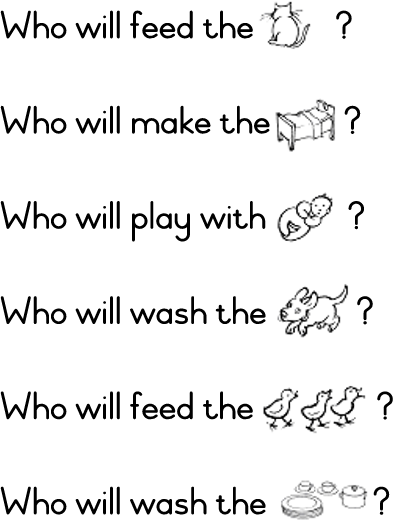| << Chapter < Page | Chapter >> Page > |
In Grade 2 the learners will build new experiences in the additional language on those learnt in Grade 1 as well as those learnt in their Home Language. They will continue to need many listening and speaking opportunities so as to develop their reading and writing skills in Grade 2.
A wide vocabulary is very important. The ICS modules for Grade 2 provide opportunities for the revision of Grade 1 vocabulary and they gradually introduce and consolidate new vocabulary by means of poems, rhymes, stories, riddles and jokes and games to play.
Learners are encouraged to answer questions, and to take part in discussions and conversations on familiar topics.
The attention is drawn to the sounds of letters in the additional language and learners discover that some letters sound the same as in their home language whereas others differ.
Although the educator will attend to correct pronunciation at this stage, learners should always be encouraged to speak the additional language without feeling incompetent and self-conscious.
By keeping the dictionary pages at the end of each module in a file, learners can revise the vocabulary and use these lists as a personal dictionary to which they can refer when completing or writing sentences and stories.
Time scheduled for the modules 1 to 8
It is suggested that the average learners complete all eight modules during the year, completing ± two modules per term.
The slower learners will proceed at their own pace while the quick learners can be given more tasks if necessary.
All learners in Grade 2 should be exposed to all the listening, speaking and reading activities in these eight modules to ensure that progression occurs throughout.
Farmer Brown and his family are introduced and activities involve their responsibilities and the jobs they do. Names of fruits and vegetables are extended, revised and consolidated by means of interesting activities.
Reading of riddles and stories are encouraged.
A counting rhyme is included and coins are counted integrating the learning area of mathematics with that of Literacy.
The basics of economics are introduced as learners understand the farmer produces the products to sell in order to have money to buy necessities for his family.
Integration of themes
The farmer needs people to help him work on the farm – he creates job opportunities and the workers in turn have a responsibility towards their employer
Everyone has the right to earn money so as to become self-sustaining.
The farmer cares for his crops and his family and shows responsibility by handling his finances in a capable way.
The farmers grows fruit and vegetables and sells these to the people.

…………………………………………………………………………………………..
milk the cows

…………………………………………………………………………………………..
pick the fruit

………………………………………………………………………………………….
feed the animals

………………………………………………………………………………………….
buy the food

………………………………………………………………………………………….
go to the market

………………………………………………………………………………………….
visit the bank
| LO 1.1.3 | LO 3.1.5 |

…………………………………………………………………………………………
bake the bread

………………………………………………………………………………………….
cook the food

………………………………………………………………………………………….
make the tea

………………………………………………………………………………………….
feed the children

………………………………………………………………………………………….
water the garden

………………………………………………………………………………………….
weed the garden
| LO 1.1.3 | LO 3.1.5 |

Nicky will …
………………………………………………………………………………………….
………………………………………………………………………………………….
………………………………………………………………………………………….

Tanya will …
………………………………………………………………………………………….
………………………………………………………………………………………….

| LO 1.1.3 | LO 4.12 | LO 6.1 |


| LO 2.1 | LO 3.1 |
Learning Outcome 1: LISTENING : The learner is able to listen for information and enjoyment and respond appropriately and critically in a wider range of situations.
Assessment Standard 1.1: We know this when the learner shows understanding of simple stories:
1.1.3 draws a picture about the story and copies a few words about it;
Learning Outcome 3: READING AND VIEWING : The learner is able to read and view for information and enjoyment, and respond critically to the aesthetic, cultural and emotional values in texts;
Assessment Standard 3.1: We know this when the learner uses pictures to understand written texts:
3.1.5 draws a picture to illustrate a sentence;
Learning Outcome 4: WRITING : The learner is able to write different kinds of factual and imaginative texts for a wide range of purposes.
Assessment Standard 4.12: We know this when the learner writes lists.
Learning Outcome 6: GRAMMAR AND VOCABULARY : The learner knows and is able to use the sounds, vocabulary and grammar of the language to create and interpret texts.
Assessment Standard 6.1: We know this when the learner understands and uses some questions forms (e.g. what happened yesterday?).

Notification Switch
Would you like to follow the 'English first additional language grade 2' conversation and receive update notifications?